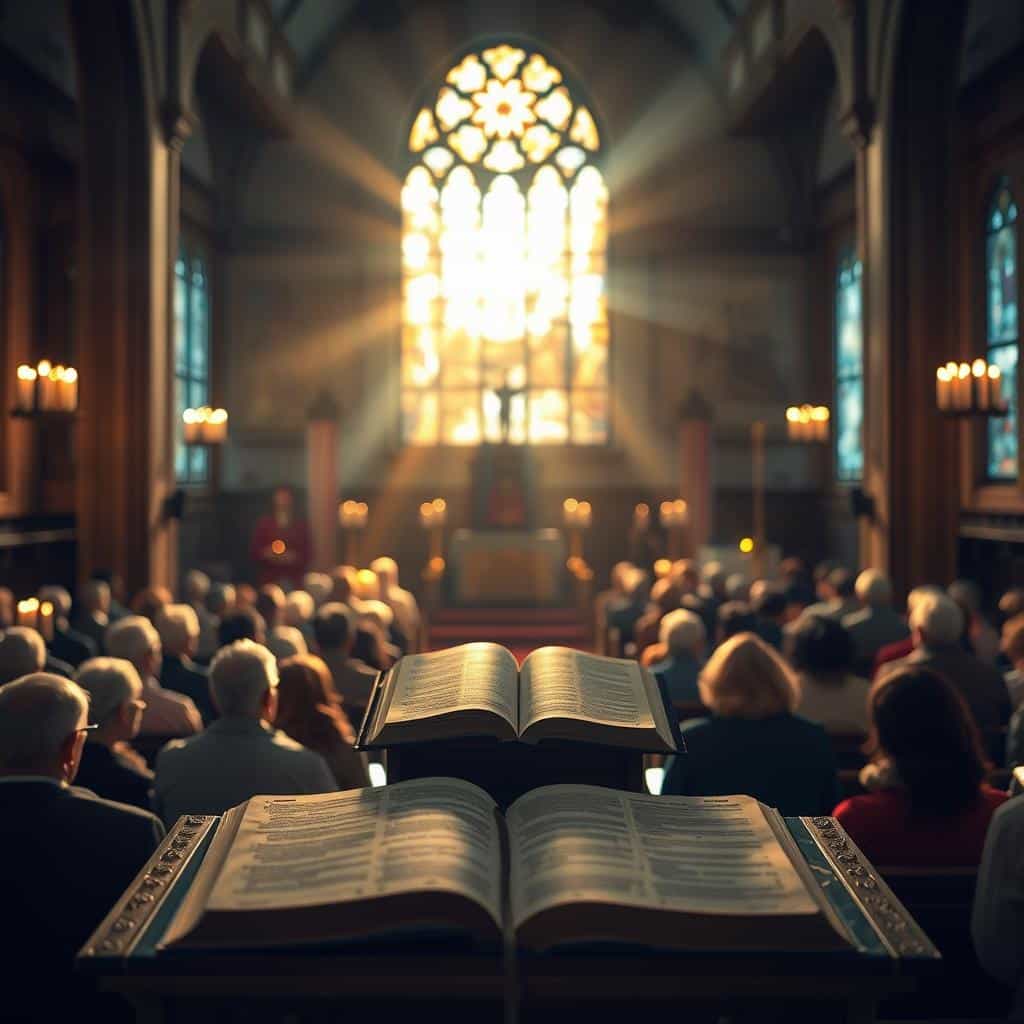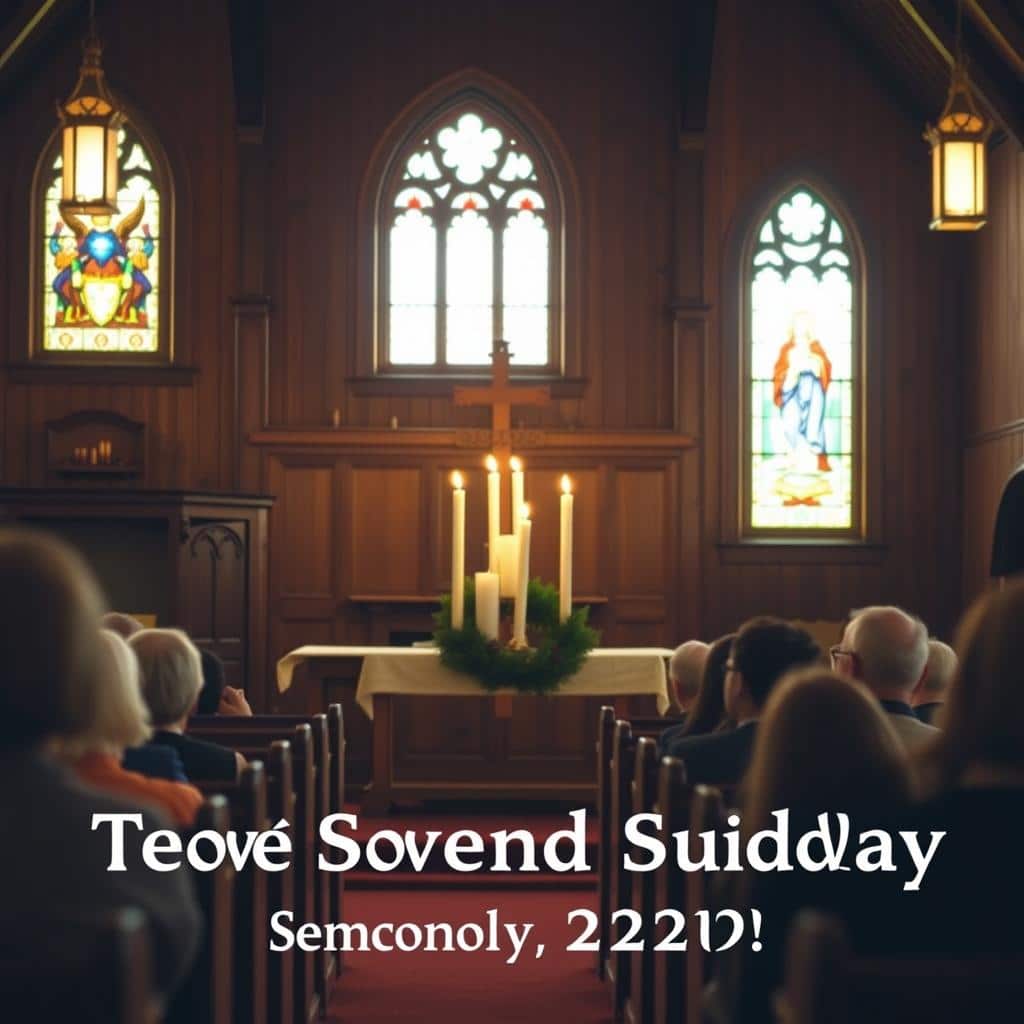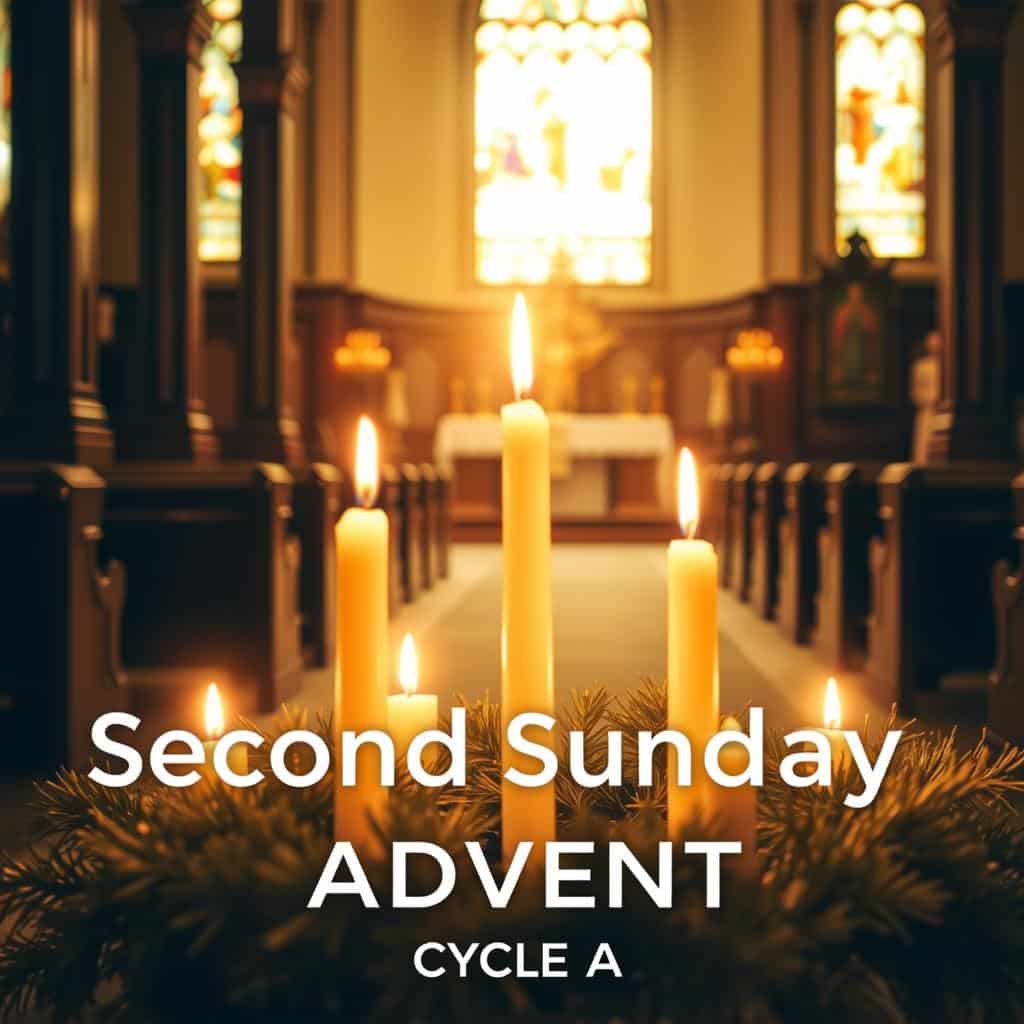Prepare your heart for a week of hopeful waiting. This guide helps U.S. parishes and families plan prayer, music, and simple rituals tied to Isaiah 11:1-10, Psalm 72, Romans 15:4-9, and Matthew 3:1-12.
Be still and know—Psalm 46 invites quiet attention as you light the second purple candle. The theme ties messianic promise, royal justice, and prophetic call into practical steps for worship and home devotion.
John the Baptist’s urgent voice in Matthew frames a day of conversion and readiness. Use short prayers, scriptural cues, and musical suggestions to shape a meaningful morning or liturgy that points to hope and peace in the time ahead.
Key Takeaways
- Cycle A readings highlight messianic hope, justice, and prophetic preparation.
- Begin with stillness and short prayers rooted in Psalm 46.
- Light the second purple candle as a sign of faith and resolve.
- Practical tips help worship leaders and families plan liturgy and home rituals.
- Expect concrete guidance for music, readings, and brief catechesis to foster unity and anticipation.
Why the Second Sunday of Advent Matters: Preparing in Hope, Peace, and Anticipation
This moment asks communities to prepare inwardly and outwardly so hope can take flesh among people. Short Scripture readings shape a clear call: Isaiah 11 paints a ruler filled with the Spirit who brings justice and wide peace.
Psalm 72 prays for leaders who protect the vulnerable and let peace flourish. Liturgy here forms public and personal responsibility and moves longing into action.
Paul in Romans teaches endurance and encouragement. Scripture builds unity between Jews and Gentiles and gives a how-to posture for faithful life. That posture guides practical preparation this week.
Matthew’s portrait of John the Baptist centers repentance that clears space in our hearts. Use confession lines, outreach plans, and quiet prayer times to make room for the Lord in daily life.
- Turn longing into concrete steps: prayer, reconciliation, and hospitality.
- Emphasize justice for the poor as a sign of true peace.
- Help people leave worship with a clear plan for continued preparation.
Advent Meaning and Symbolism: From “Coming” to Conversion
This season draws believers toward meaningful waiting and inner conversion. Advent comes from Latin adventus, which means “coming,” and it has long guided prayer and fasting before Christmas.
Lighting the second purple candle centers faith and waiting. The candle asks families and parishes to pause, pray, and make room inwardly for God’s presence.

Lighting the second purple candle: faith, waiting, and holy anticipation
Use simple words at the wreath: a short verse like Psalm 46:10 helps anchor the practice. Keep the moment brief, sacred, and repeatable for children.
Prophecy fulfilled and future glory: holding first and second comings together
Prophecy and fulfillment meet in one story across years. The child in Bethlehem and the risen Lord point to the same promise.
- Define the season as looking to Christ coming in history, in grace, and at the final return.
- Make waiting active: acts of mercy and reconciliation show faith in practice.
- Set a home wreath spot, read a short verse, and reflect on how peace shapes the week.
“Be still, and know that I am God.”
| Symbol | Focus | Simple Practice |
|---|---|---|
| Second purple candle | Faith and waiting | Light, read Psalm 46:10, brief silence |
| Wreath location | Household attention | Designate spot, gather, pray |
| Prophecy link | Past promise, future glory | Read Isaiah briefly, name hope aloud |
Readings Overview for the Second Sunday of Advent (Cycle A)
The appointed texts weave a portrait of righteous leadership, communal unity, and prophetic challenge. Each reading adds a layer: messianic promise, royal prayer, pastoral formation, and a prophetic call to conversion.
Reading 1: Isaiah 11:1-10 — A shoot from Jesse, the Spirit’s gifts, and a peaceable kingdom
Isaiah 11 promises a ruler from Jesse who bears the spirit of wisdom, understanding, counsel, might, knowledge, and fear of the Lord. The passage imagines creation living in harmony under just rule. Use this text to highlight how god kingdom vision reshapes leadership and community.
Responsorial Psalm: Psalm 72:1-2, 7-8, 12-13, 17 — Justice shall flourish and peace till the moon be no more
Psalm 72 is a royal prayer for a king who judges with justice and defends the poor. The psalm’s words function as liturgical petition and public message about care for the vulnerable. Emphasize the psalm’s refrain in communal prayer.
Reading 2: Romans 15:4-9 — Endurance, encouragement, and unity for Jews and Gentiles
Paul counsels endurance and hope rooted in Scripture so that diverse peoples might glorify God together. This text serves as a pastoral roadmap: Scripture forms a single body able to praise and welcome all.
Gospel: Matthew 3:1-12 — John the Baptist: “Prepare the way,” repentance, and baptism with the Holy Spirit and fire
Matthew presents john baptist as the prophetic alarm. He calls for authentic repentance, warns against hollow presumption, and points to One who will baptize with the god spirit and fire. Preachers can frame John’s words as a summons to realignment before the stronger One arrives.
- Homiletic hooks: justice for the poor, unity across divides, and conversion that bears fruit.
- Suggest a brief catechesis before Mass to show how these readings interlock.
- Invite lectors to pray over key phrases and cadence so proclamation matches the texts’ gravity and hope.

How to Prepare Your Heart This Week
This week offers a clear plan to prepare hearts through short, practical acts. Benedict XVI taught that John’s call invites present change, not vague intention.

Be still and pray: making space for God’s presence in busy lives
Start with a daily 10-minute prayer time today. Let Psalm 46:10 shape that silence. Keep it simple: breathe, read Isaiah 11:1-10, and listen.
Repentance in action: making straight paths with concrete steps
Repentance must show fruit. Use a short checklist from Matthew 3: pick one relationship to repair, one habit to change, and one service step for people in need.
Choosing harmony: welcoming others to reflect Christ’s coming kingdom
Follow Romans 15:4-9 by practicing unity. Invite someone different to a meal, join a parish welcome team, or simplify plans so prayer fits your day.
- Journal three moments you sensed God each day.
- Recite a brief prayer before tasks: “Lord, prepare my heart.”
| Action | Scripture | Simple Step |
|---|---|---|
| Be still | Psalm 46:10 | Daily 10-minute silence |
| Repentance | Matthew 3:1-12 | Repair one relationship |
| Welcome | Romans 15:4-9 | Host or serve newcomers |
Praying the Responsorial Psalm: Justice, Mercy, and the King Who Cares
Let the responsorial psalm shape weekly petitions for care, peace, and wise leadership. Psalm 72 prays that the king judge with justice and defend the poor. Its vision links righteous rule with mercy for all people and blessing for the nations.

Key refrains to carry through the week
Use short lines from the psalm as breath prayers. Repeat phrases like “Justice shall flourish” and “peace abound” during quiet moments to keep hope present.
Simple prayer practice
Intercede daily for civic and Church leaders by name. Ask that they govern with wisdom, protect the vulnerable, and seek the common good.
- Broaden intentions to include the earth and international peacemaking.
- Close family meals with a doxology: “May his name be blessed forever.”
- Link parish service projects to Psalm 72’s care for the poor.
Music tip: choose a Psalm 72 setting that reinforces justice and peace for the sunday advent liturgy. This posture presses daily choices toward the god kingdom vision found in these words.
Engaging the Gospel: John the Baptist’s Call Today
In the Judean wilds John speaks a sharp summons that still cuts through our noise today. Matthew 3:1-12 shows him calling, “Repent, for the kingdom of heaven is at hand.” His words demand real change, not just pious talk.
From desert to daily life
From desert to daily life: hearing the voice in our internal and external deserts
Translate the desert image into solitude: turn off devices for 15 minutes to hear the voice that calls you back to God. Place a small rock or simple cross on your table as a desert symbol to prepare way lord in routine moments.
Bear good fruit: avoiding spiritual pride and embracing authentic change
Repentance means a change of mind and direction that bears visible fruit. John warns against relying on status or ancestry; spiritual pride blocks inner reform and harmfully shapes our lives.
Confession and renewal: preparing for the One who baptizes with the Holy Spirit
Offer a step-by-step confession guide this week: name the fault, make a concrete amends, adopt a new habit, and invite a friend to reconciliation. Frame baptism with the Holy Spirit and fire as God’s purifying love that readies us to serve.
“Repent, for the kingdom of heaven is at hand.” — Matthew 3:2

- Practice 15 minutes of device-free silence each day.
- Turn named sins into specific amends and new habits.
- Invite someone to an Advent penance service as witness to renewed life.
Worship and Music Planning for the Second Sunday of Advent
A well-crafted musical arc guides people from an urgent call to calm listening and renewed mission.
Prepare the Way themes — repentance, waiting, and the Spirit’s power — should thread through hymn choices and sung prayers.
“Prepare the Way” themes: repentance, waiting, and the Spirit’s power
Start strong. Open with a piece that gives clear voice to John’s call to prepare way lord so the assembly hears the demand for change.
Include one selection that invokes the spirit and its transforming power to connect with the Gospel’s promise of baptism with fire.
Suggested hymns and songs
Suggested repertoire: On Jordan’s Bank, Every Valley, Ready the Way, Wait for the Lord.
- Use On Jordan’s Bank to give voice to John’s message.
- Sing Every Valley to echo Isaiah’s comfort and hope.
- Include a Psalm 72 setting to underline justice and peace.
- Consider Taizé’s Wait for the Lord for a listening moment.
“Let the sung word prepare hearts and send the assembly in mission.”

Practical Ways to Celebrate at Church and at Home
Short, shared actions at church and home make the season meaningful and manageable. Use brief, repeatable practices so busy families and parish groups can join in without stress.

Jesse Tree, candle lighting, and Scripture sharing for families and small groups
Jesse Tree: Start a simple starter list of daily symbols. Feature Isaiah’s “shoot from Jesse” symbol today to link past promises across years to Christ.
Candle ritual: Light the second purple candle together. Read a few verses from Isaiah 11:1-10 or Matthew 3:1-12. Then each person names one way they will prepare hearts this week.
- Small groups: read Romans 15:4-9, discuss encouragement, and plan one service action for people in need.
- Parents: keep Scripture sharing to 10 minutes so children stay engaged.
- Create a family intentions jar to lift leaders and the poor, echoing Psalm 72’s concern for justice and peace.
“Let this time shape habits of prayer and service that last beyond the season.”
Practical parish idea: Offer a one-page guide for home use that lists the readings for the day (Isaiah 11:1-10; Psalm 72:1-2,7-8,12-13,17; Romans 15:4-9; Matthew 3:1-12), a short Jesse Tree starter, and quick service suggestions.
| Practice | Scripture | Quick step |
|---|---|---|
| Jesse Tree symbol | Isaiah 11:1-10 | Display “shoot from Jesse” |
| Candle lighting | Readings second sunday | Light candle, one commitment |
| Community action | Romans 15:4-9 | Plan one service this week |
Second Sunday of Advent, Cycle A
This week’s readings invite a clear choice: welcome justice that heals and prepare a home for the Lord. Isaiah shows a Spirit-filled ruler who brings right judgment. Psalm 72 prays for a king who defends the poor. Romans calls the community to unity. Matthew summons honest repentance so people can receive grace.
Restate the core message simply: Christ’s justice brings peace, Scripture builds hope, and repentance opens us to God’s gift today.
Make one concrete decision for the week. Pick a specific act: repair a relationship, join a parish service, or set a daily five-minute prayer time. Let that choice keep sunday advent momentum alive.
Leaders: craft announcements that give a single takeaway and a clear next step. Share a short verse on social media to center the community on hope and peace during weekdays.
“Decide now how you will receive the Lord into your heart and parish.”

| Reading | Focus | Practical step |
|---|---|---|
| Isaiah 11:1-10 | Spirit-led justice | Act for the vulnerable |
| Psalm 72 | Care for the poor | Pray for leaders |
| Romans 15:4-9 & Matthew 3:1-12 | Unity and repentance | Choose one change this week |
Invite feedback after the week: ask what helped people pray well and refine practices for the coming Sundays. This keeps the liturgical coming both public and personal.
From Prophecy to Practice: Living Isaiah’s Peace and Paul’s Unity
A vision of harmony in Isaiah urges concrete steps so hope touches real neighbors. Use Isaiah 11 and Romans 15 to move parish plans from idea to action.
Seek justice, make peace: leadership, service, and care for the vulnerable
Translate Isaiah’s imagery into advocacy and ministries that serve the poor. Let parish committees review policies through the lens of the god kingdom and the dignity of people most affected.
Set multi-year goals for social mission that mirror the king-shaped priorities in Psalm 72. Link repentance to public virtue: honest finances, truthful speech, and faithful commitments show new life in practice.
Adopt creation-care steps to honor the earth God made. Train volunteers in welcome and hospitality as a preparation to unite diverse cultures into one praising body.

| Action | Scripture | Timeframe (years) | Impact |
|---|---|---|---|
| Advocacy for poor | Isaiah 11:1-10 | 1–3 | Increase peace in local lives |
| Parish social plan | Psalm 72 / Romans 15 | 3–5 | Stronger god kingdom witness |
| Volunteer training | Romans 15:4-9 | 1 | Better welcome for people |
“Let st. john’s courage and Paul’s call to unity guide preparation for the coming Lord.”
Conclusion
Let these readings guide a clear, practical plan to ready our hearts this week. Isaiah 11:1-10, Psalm 72:1-2,7-8,12-13,17, Romans 15:4-9, and Matthew 3:1-12 converge on one message: prepare way with prayer, mercy, and honest change.
Prepare hearts through short daily prayer and one concrete act of service. Mark a time this week for confession and another time to serve so repentance becomes visible hope and peace in everyday life.
Worship leaders: choose one simple action step the assembly can take to carry second sunday grace into workplace and neighborhood. Bless families with a brief sending prayer so the way lord stays at the center of routines and future discipleship.
Give thanks for Scripture’s guidance and commit to walk this way together in the remaining weeks, letting words shape lives today.





